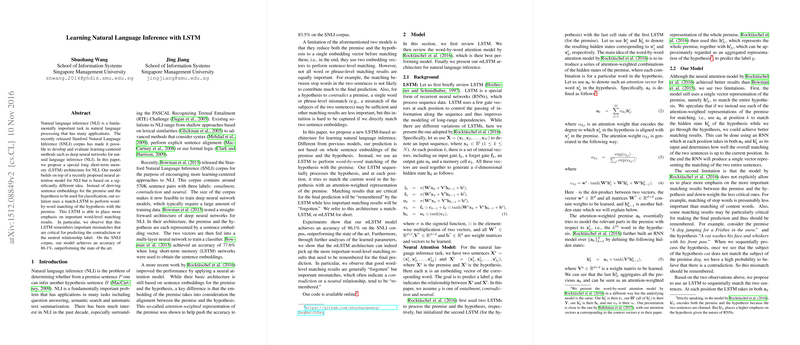Learning Natural Language Inference with LSTM
This paper presents an innovative approach to Natural Language Inference (NLI) through a specially designed Long Short-Term Memory (LSTM) network, addressing challenges inherent in existing models. The focus is on leveraging deep learning techniques, particularly LSTM architectures, to improve the accuracy of determining entailment, contradiction, or neutrality of sentence pairs on the Stanford Natural Language Inference (SNLI) corpus.
The authors propose a match-LSTM architecture, distinctively employing word-by-word matching of hypotheses with premises. This method diverges from previous approaches that primarily relied on sentence-level embeddings for classification, potentially overlooking critical word-level mismatches that significantly inform inference outcomes. By emphasizing direct word matching, the model strives to capture pivotal mismatches that are instrumental in identifying contradictions or neutral relationships within sentence pairs.
The empirical evaluation of the proposed model demonstrates a substantial advancement in performance metrics. On the SNLI corpus, the match-LSTM model achieved an accuracy of 86.1%, surpassing the previous state-of-the-art results of 83.5% from models employing sentence embeddings augmented with neural attention mechanisms. Not only does this underline the efficacy of the match-LSTM approach in improving inference, but it also highlights the potential of refining LSTM architectures for nuanced language tasks.
The paper also provides insight into the functioning and optimization of the model. The LSTM's ability to remember critical mismatches while disregarding less relevant matches is a key feature that supports enhanced decision-making in NLI tasks. Such memory mechanisms ensure that the model retains and utilizes relevant linguistic structures and semantic discrepancies effectively.
Several implementation considerations are discussed, including the use of GloVe embeddings for word representation and optimization through the Adam method. These choices, combined with specific architectural enhancements such as bi-directional LSTMs, contribute to the robustness and accuracy of the match-LSTM model.
The implications of this research extend to various NLP applications requiring nuanced understanding of sentence relationships, such as question answering and semantic search. Moving forward, the theoretical advancements presented in this paper could inform further development in neural architectures for broader NLP challenges, including those requiring less extensive datasets, enhancing their versatility and applicability.
In conclusion, the match-LSTM architecture presents a substantive improvement in the field of NLI, setting a new benchmark for accuracy and providing a methodological framework that balances memory and attention mechanisms within LSTM networks. Future research could explore hybrid approaches or integration with other linguistic resources to overcome limitations related to data dependence.
